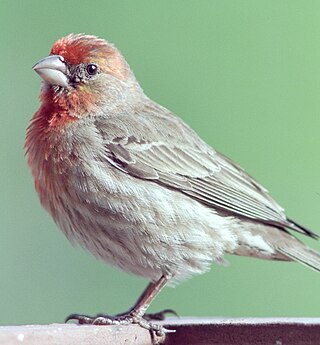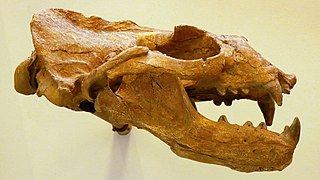
The Mexican tetra, also known as the blind cave fish, blind cave characin or the blind cave tetra, is a freshwater fish in the Characidae family of the order Characiformes. The type species of its genus, it is native to the Nearctic realm, originating in the lower Rio Grande, and the Neueces and Pecos Rivers in Texas, into the Central Plateau and eastern states of Mexico.

The House finch is a North American bird in the finch family. It is native to Mexico and southwestern United States, but has since been introduced to the eastern part of North America and Hawaii; it is now found year-round in all parts of the United States and most of Mexico, with some residing near the border of Canada. There are estimated to be 40 million house finches across North America, making it the second-most populous finch, just behind the American goldfinch. The house finch and the other two American rosefinches are placed in the genus Haemorhous.

The Mexican prairie dog is a diurnal burrowing rodent native to north-central Mexico. Treatment as an agricultural pest has led to its status as an endangered species. They are closely related to squirrels, chipmunks, and marmots. Cynomys mexicanus originated about 230,000 years ago from a peripherally isolated population of the more widespread Cynomys ludovicianus.

Astyanax jordani is a freshwater fish of the characin family of order Characiformes, native to Mexico. It is sometimes called the cave tetra, or by its local Spanish name sardina ciega.

The Mexican hornshark is a bullhead shark of the family Heterodontidae. This shark is grey-brown in color, with black spots scattered on the fins and body. It has a cylindrical trunk, conical head, and small spiracles behind the eyes. The snout of the Mexican hornshark is very round and blunt. Like all members of the order Heterodontiformes, this shark has fin spines in front of both of its dorsal fins. The first dorsal fin originates before the pectoral fins, while the second dorsal fin originates behind the pelvic fins. The Mexican hornshark reaches a maximum length around 70 cm, but usually reaches between 50 and 60 cm on average. Young hornsharks hatch around 14 cm.

Dinohippus is an extinct equid which was endemic to North America from the late Hemphillian stage of the Miocene through the Zanclean stage of the Pliocene and in existence for approximately 6.7 million years. Fossils are widespread throughout North America, being found at more than 30 sites from Florida to Alberta and Panama.

The Mexican vole is a species of vole.

The Mexican deer mouse is a species of forest-dwelling rodent in the family Cricetidae. It is found in southern Mexico and throughout much of Central America.
The Rio Verde catfish is a species of North American freshwater catfish endemic to the Pánuco River basin in San Luis Potosí, Mexico.

Thalassoleon is an extinct genus of large fur seal. Thalassoleon inhabited the Northern Pacific Ocean in latest Miocene and early Pliocene. Fossils of T. mexicanus are known from Baja California and southern California. T. macnallyae is known from central California, and T. inouei is known from Japan. Thalassoleon could be the ancestor of the modern northern fur seal.

Juncus balticus subsp. mexicanus, synonym Juncus mexicanus, is a species of rush known by the common name Mexican rush. It is native to much of the west of the United States, Mexico and Central and South America. It is a plant of moist areas in a great number of habitats, from coast to desert to mountain and low to high elevation.

Juncus balticus is a species of rush known by the common name Baltic rush. It is a perennial flowering plant in the family Juncaceae. It can reach a height of about 75 centimetres. It is native to north-western Europe from Spain to northern European Russia, most of North America except the south-eastern United States, parts of Mexico and Central America, and western and southern South America from Colombia to Argentina. It is available from specialist nurseries for landscaping and soil stabilization purposes.
Ideoblothrus is a genus of pseudoscorpions in the Syarinidae family. It was described in 1892 by Italian naturalist Luigi Balzan as a subgenus of Ideobisium.
Ideoblothrus curazavius is a species of pseudoscorpion.
Ideoblothrus ceylonicus is a species of pseudoscorpion.
Ideoblothrus maya is a species of pseudoscorpion. It is only found within the type locality of one unnamed cave off San Roque Road in Oxkutzcab, Yucatán, Mexico.
Ideoblothrus godfreyi is a species of pseudoscorpion. It is known exclusively from the type locality of Frankfort Hill, King Williams Town Div., Cape Province, South Africa.
Ideoblothrus grandis is a species of pseudoscorpion. It is only found within Cueva del Tio Ticho, Chiapas, Mexico.
Ideoblothrus seychellesensis is a species of pseudoscorpion. It is found in the Seychelles on Felicite Island and Silhouette Island. As of 2012, the species has been considered endangered and is listed on the IUCN red list.
Ideoblothrus vampirorum is a species of pseudoscorpion. It is found within a cave known as the Cueva de los Vampiros in the Mexican state of Tamaulipas, from which it derives its name.










